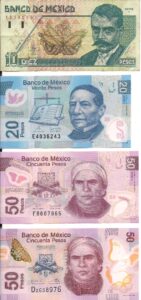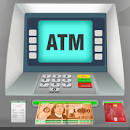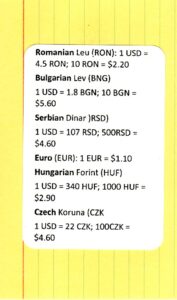 While the U.S. Dollar is generally regarded as one of the most widely accepted currencies around the world, there are places where you cannot use your home currency, U.S. Dollar or otherwise. In such a case, you will need to have some of the local currency for your purchases, for tips, etc. The length of time that you will be in a given country (or in areas that use a common currency) will dictate how much of the local currency to have on hand.
While the U.S. Dollar is generally regarded as one of the most widely accepted currencies around the world, there are places where you cannot use your home currency, U.S. Dollar or otherwise. In such a case, you will need to have some of the local currency for your purchases, for tips, etc. The length of time that you will be in a given country (or in areas that use a common currency) will dictate how much of the local currency to have on hand.
That amount will also depend on the types of activities you are doing. If you are on a structured guided tour with included meals, you might want to have the equivalent of up to $50.00 per day. Why this much if everything is already included? You might want a snack or cold drink along the way. Plus, you will have some to tip your guides, the hotel or dining staff, and it is always better to have the local currency. Even if you have some ones and fives from home, you would be putting the burden on them to have to exchange your dollars.
I see many travelers using an ATM to get local currency once they are in a country. There are at least two risks associated with getting the local money that way. One of them happened to me recently in Europe. I went to an exchange house to change dollars; they were busy, and so I put my card into an ATM outside. The machine wouldn’t work, and I couldn’t get my card out. It took a young man, who had been in the place with friends, about a half hour to work to get my card out. Fortunately the card wasn’t ruined, or the rest of my trip could have been in jeopardy.
LESSON: do not use stand-alone ATMs.
 Another risk in using an ATM is the amount of fees you might be charged by your bank for using your card that way. Some banks (or card companies) don’t charge fees; but you should at least be aware of what they are, if any. Also, the exchange rate might not be very good. But if you are getting only a small amount, a hundred dollars or so, then the exchange rate difference might not make that much difference.
Another risk in using an ATM is the amount of fees you might be charged by your bank for using your card that way. Some banks (or card companies) don’t charge fees; but you should at least be aware of what they are, if any. Also, the exchange rate might not be very good. But if you are getting only a small amount, a hundred dollars or so, then the exchange rate difference might not make that much difference.
My preference, especially if I know that I might need several hundred dollars or more in a given currency is to get it from my bank. Yes, I might pay a $10 fee, but that becomes immaterial when getting a large amount. I will have the money in a couple days, or even right away, and I don’t have to go looking for an exchange house or ATM as soon as I get to a country. If you are on a cruise, and or going on a tour, there might not be ANY time to do any exchanging.
Of course, if I am on a cruise where I am visiting countries for just a partial day at a time, then it’s not practical for me to get the local currency for each country.
 This card is from a set of river cruises that I recently enjoyed (Bucharest to Budapest, and then Budapest into Lower Bavaria) followed by three days in Prague. [by the way, if you would like me to help you find the perfect river cruise, please visit my travel agent site Travel with Stuart.] I carried this card in my pocket, and it was an easy reference in the various countries that we visited. I like to use a consistent format when I make items like the card; it helps to eliminate some confusion.
This card is from a set of river cruises that I recently enjoyed (Bucharest to Budapest, and then Budapest into Lower Bavaria) followed by three days in Prague. [by the way, if you would like me to help you find the perfect river cruise, please visit my travel agent site Travel with Stuart.] I carried this card in my pocket, and it was an easy reference in the various countries that we visited. I like to use a consistent format when I make items like the card; it helps to eliminate some confusion.
Plus as I went into a shop I knew ahead of time what the local price was approximately in dollars. I do have some limits on how much I will pay for certain items. But even if the price isn’t terribly important, I still like to know how much. Wouldn’t you?
For this particular trip, I had gotten (from my bank, per above) currency for Romania, Hungary, and the Czech Republic because I was going to be in those countries for three days each. We had a one-day stop in Serbia, and that didn’t warrant getting Dinars for that short stop; and Croatia, Slovakia, and Germany use the Euro — which I always have (since I love traveling in Europe).
The next time you are in a country that uses a different currency, try using the local money. It gets you a little closer to traveling like a local. The locals will appreciate it; that is for sure. In another tip, I will give you an idea for what to do with any of the currency (and coins) that are left over after your trip. For now, use it as an excuse to think about going back for another trip,
Where do you find the exchange rate for a given currency?
There are lots of places, and there might even be some discrepancy between them for the same currency. I don’t have a preference, but here are a few, using the Euro to U.S. Dollar as an example:
www.xe.com/currencyconverter/convert/?Amount=1&From=EUR&To=USD
www.bloomberg.com/quote/EURUSD:CUR
www.forbes.com/advisor/money-transfer/currency-converter/eur-usd/
finance.yahoo.com/quote/EURUSD=X/
If you are not yet getting my weekly newsletter that also contains a Travel Tip like this one, Click Here to sign up, and get a free copy of my novel Murders in SYDNEY.
Happy Travels — Thanks for reading!
Stuart Gustafson, America’s International Travel Expert®
1 thought on “TRAVEL TIP #908: Using Local Currency”
Comments are closed.